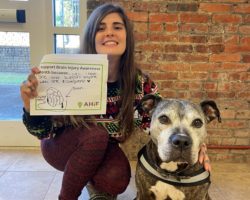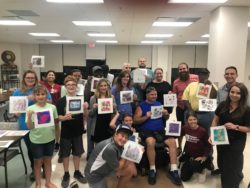Brain Strong!

TBI Survivor Cecilia and her therapy dog, Magnum, at WMA for the monthly AHIF Support Group Meeting.
My father had an inoperable brain tumor. Because of the location of his tumor he had short term memory loss, which affected his concentration and focus, as well as motor skill deficiencies, especially on his right side as his tumor was located in his left frontal lobe. His physical therapist suggested incorporating art activities as part of his therapy plan. Why? In addition to being an enjoyable way to express one’s creative side, art can improve fine motor skills and help with concentration and focus. The Philly Art Center explains:
“One of the most important skills that are developed through art is fine motor development. During art lessons, your child’s small muscles in the fingers, hands, and wrists are exercised and strengthened, helping to make learning to write easier. You may not realize it, but the control over finger movements used for clay modeling and finger painting is the same control the child needs to be able to grasp a pencil and write.”
But my father was an adult when he developed Glioblastoma. What about fine motor skills in older children or even adults? The benefits are still present. Kate Maroldi writes on her blog The Gift of Gab:
“While it may be more difficult to begin or may cause some pain if done for too long, the benefits of slowly easing yourself into art are immense… Motor skills, which often decline in later life, are tested and strengthened with activities that can be adjusted to the comfort level of the participant. Painting with acrylic, for example, puts less stress on the hands than drawing, and crocheting requires less fine motor skills and works better for shaking hands than painting.”
So, how can the act of creating help improve our cognitive skills? A blog post from the Dana Foundation explains:
“The idea that training in the arts improves cognition generally really is not so bold within the context of what we call activity-dependent plasticity, a basic tenet of brain function. It means that the brain changes in response to what you do. Put another way, behavior shapes and sculpts brain networks: What you do in your day-to-day life is reflected in the wiring patterns of your brain and the efficiency of your brain’s networks. Perhaps nowhere is this more evident than in your attention networks. For most of us, if we find an art that “works” for us—that incites our passion and engages us wholeheartedly—and we stick with it, we should notice improvements in other cognitive areas in which attention is important, such as learning and memory, as well as improving cognition in general.”
My father’s experience with his tumor informed my approach to outreach with traumatic brain injury survivors with the Alabama Head Injury Foundation or AHIF. AHIF’s mission is to “improve the quality of life for survivors of traumatic brain injury and their families.” Through support groups, camps, caregiver programs, theraputic and counseling services AHIF is touching the lives of more than 4500 people statewide. Since 2019, WMA has provided art activities quarterly for their in person and online support group meetings furthering our commitment to health an wellness through the arts.

AHIF Wiregrass Support Group Meeting, August 2019
The Wiregrass Area Support Group met in person for the first time since COVID last month and the joy in the room was invigorating. We are so pleased to be able to offer them space to learn, connect, and enjoy each other’s company.
So why is art and the brain on my brain this month? I am pleased to announce that this week, I will be presenting a workshop at the ABLE Assembly at the Berklee Institute for Accessible Arts Education about my experience with AHIF and making art accessible for those with traumatic brain injuries. If you are interested in ensuring that art is accessible for ALL students, I encourage you to visit their website and take advantage of the many free resources available. There’s still time to register for the ABLE Assembly as a virtual attendee, too. Join me as I learn from colleagues from across the country about how we can ensure that students of all abilities have the opportunity to learn and grow through the arts! Art is for everyone!
